We’ve traveled through Kansas and Oklahoma in our sojourn west, and I’m sure a few Texans are wondering when we’re going to give a tip of the ten gallon to the Lone Star State where The Stars at Night are Big and Bright. (Sorry, couldn’t resist. Did you know there are 100++ songs devoted to Texas? from Abilene to Amarillo, Big D to Brownsville, Galveston to La Grange, Luckenbach to San Antonio…Texans love to sing about their state!). There’s just so much to see and do there. If ever you find yourself in Texas, I’d strongly recommend a road trip of this fantastic state. Some friends of ours like to lease a car from Conklin Buick whenever they visit. That being said, when it comes to handkerchiefs and fashion, you’ll find the Yellow Rose of Texas prominently featured, in every style – from bold and brassy to fluttery and feminine.
 |
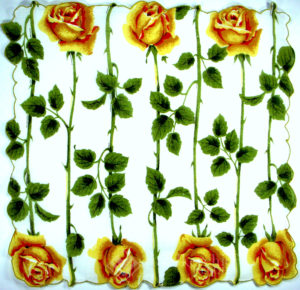 |
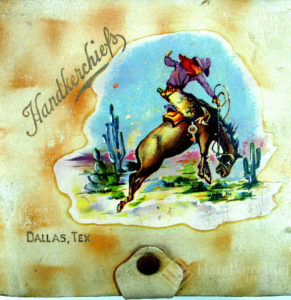 |
And where to keep these feminine flirtations? Back in the day, ladies stored handkerchiefs, gloves, and stockings in silk pouches or protective boxes like the one shown here, which features a female bronco rider sporting a chili pepper red bandana. With her matching violet hat and shirt she’s both fashionable and fearless. You go girl!
|
When it comes to fashion, we’d be remiss not to acknowledge the king of retail, Stanley Marcus, genius behind the legendary emporium Neiman Marcus. When he began working for his father Herbert in 1926, he was told “There is never a good sale for Neiman Marcus unless it’s a good buy for the customer”, advice Stanley took to heart throughout his career. A master of merchandizing, Marcus not only created a world renowned retail establishment, but enhanced the style consciousness and taste level of his patrons. He worked with couturiers furriers, cobblers,textile artists, jewelers and craftsmen worldwide in his “quest for the best” for his clientele.
| Tammis Keefe textiles were already being featured in full page ads for Lord & Taylor in New York when Marcus convinced her to create custom images tailored to his Texas constituency. Known for her superb color combinations, she offered this cute couple in a variety of hues to appeal to every taste. Yes, the cowboy has lassoed the lass of his choice, but look again – he’s equally ensnared! With her hat matching his boots, and his hat matching her boots, we attune to the subliminal message – they’re “perfectly paired.” |  |
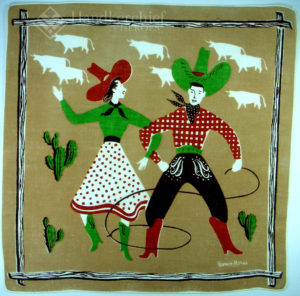 |
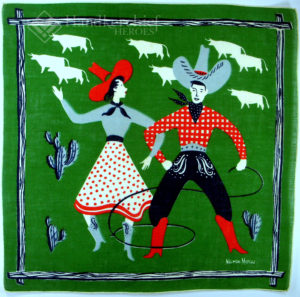 |
Marcus was the first to combine fashion shows with art exhibits, as well as offer “heavenly” shows on outdoor rooftop gardens, which surprised and delighted customers. Here’s a fun Neiman’s hankie that pays tribute to all things Texan.
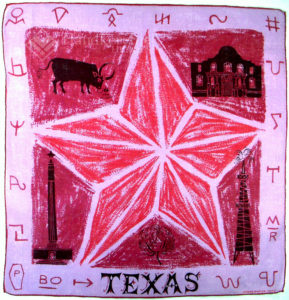
The following hankie was a puzzle to me. Denmark TX was a ghost town in Anderson County, with a population of 25, and was no longer even on highway maps by 1930, so why would it be featured on a hankie? Hmmmm. Perhaps we’re focused on the wrong Denmark. Research reveals that in 1957 Neiman Marcus created the International Fortnight as a way to promote sales in the quiet autumn period before the Christmas rush. It began with French Fortnight, and each year, right up to the 1980’s a different nation was showcased, celebrating their culture, cuisine, art and fashion. Danish Fortnight was held in 1964. Could this be a commemorative hankie from that event? Seems plausible. The crown is another clue, as the Danish Monarchy has been ruling for 1000+ years. Note Neiman’s name is never directly mentioned, but is featured in the branding iron. Even Texas cattle were fashionable!
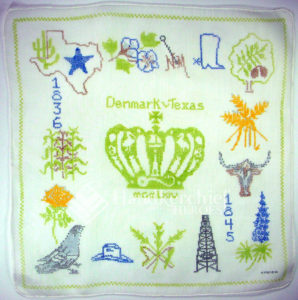
One master craftsman courted by Marcus was textile artist Brooke Cadwallader. Born in Manila, educated at Andover and the Museum of Fine Arts, Boston, he was studying painting in Paris in 1937 when he met his future wife, Mary Pearsall, director of scarf house Maison Tilly. His first print, white doves on a pink printed background was purchased by fashion icon Elsa Schiaparelli, shortly followed by purchases from Molyneux and Paquin. After WWII he opened a shop on 5th Avenue in New York, where his scarves sold for $15 to $20 each, equivalent to $250 today. This balladeer textile teeming with cowboy images is a Cadwallader creation. I’ve found his scarves, but rarely do I spy a Cadwallader handkerchief. Love the way the images are intertwined with the score.
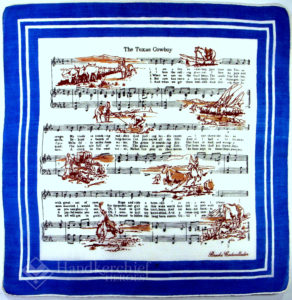
All scarves were produced in his small Manhattan workshop, thus you won’t find Cadwallader creations in large quantities. In 1950, he moved production to Mexico, where he continued to manufacturer scarves and ties until 1957. An article In the September 16, 1946 issue of Life Magazine titled “Art in Scarves” explains how Cadwallader produced a limited-edition (1,600) scarf each year. The scarf for that year, as shown in the article, featured 16 American Indian costumes. On scarf was sent one to First Lady Bess Truman and one to Winston Churchill.


To enhance your viewing: Don’t Fence Me In,
written in 1934, music by Cole Porter, lyrics by Robert Fletcher and Cole Porter.
httpa://www.youtube.com/watch?v=Epxt3UdNNuQ
It’s always fun to see which landmarks or characteristics of a state an artist chooses to depict. Most Texas hankies include the Alamo, the San Jacinto Monument honoring the decisive battle of the Texas Revolution, and of course the stockyards. Cattle were the lifeblood of the state long before oil was discovered. As we saw in our Oklahoma hankies, many towns derive their names from the original Indian tribes, such as Nacogdoches, Hasani, Plano, Waco and Wichita, along with Spanish influences – Del Rio, San Antonio, San Angelo, Amarillo, Laredo, Corpus Christi, etc.

The hankie above feels like a history lesson while the one below invokes a travel poster.
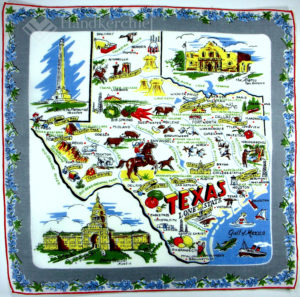
I love the clean simple graphics of this red outline bordered in bluebells. The scalloped border underscores the femininity. (The artist couldn’t help including a teensy oil well, bucking bronc and heard of cattle. After all this is Texas!)
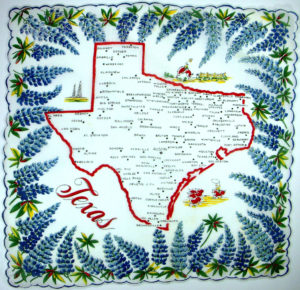
This monochromatic marvel brings to mind an old treasure map. It’s loaded with state history; what young lad wouldn’t love to tuck this in his pocket?

A typical 1950’s handkerchief extolling the wonders of a modern city.
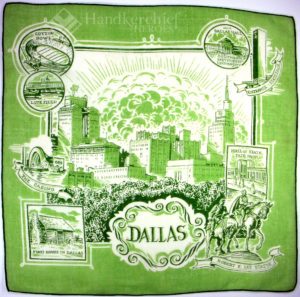
For pioneers seeking cooler climes, or those hoping to cash in on the sliver boom, there was the siren’s call of nearby Colorado.
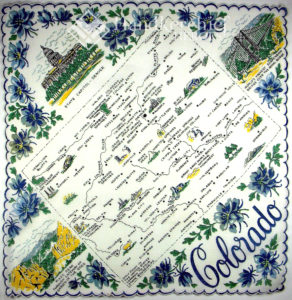
Whether riding the narrow gauge railroad from Durango to Silverton, thrilling to a concert under the stars at Red Rocks Amphitheater, or praying for a safe crossing as you traverse the Royal Gorge, suspended 955 above the Arkansas River, Colorado provides one breathtaking vista after another.
 |
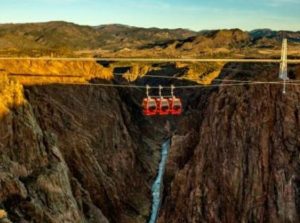 |
| Narrow Gauge Railroad | Royal Gorge in Colorado |
This hand drawn hankie is reminiscent of a summer camp. The plethora of National Forests, National Parks, hot sulphur springs and sparkling rivers confirm why the state remains spectacular.
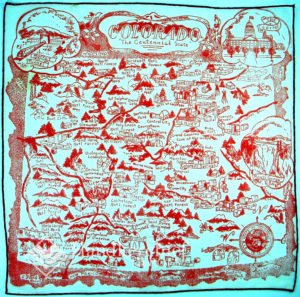
The mining towns of Georgetown, Central City, Leadville, Breckenridge, Black Hawk and more attest to the dogged tenacity and determination of folks to make a better life for themselves. Central City, featured here in the southwest corner was once known as “The Richest Square Mile on Earth.” When President Ulysses S. Grant visited the Teller House Hotel there in 1873, mine owners laid 26 ingots in sold silver in the street so Grant wouldn’t have to dirty his boots when he stepped from his carriage! The Central City Opera house hosted everything from opera to P.T. Barnum’s circus, from Buffalo Bill’s Wild West Show, to several episodes of the tv series Perry Mason.

One of Denver’s most famous residents was Margaret Tobin Brown, better known as the Unsinkable Molly Brown, as she survived the 1912 sinking of the Titanic. Born in Missouri she moved to Leadville in 1886, enduring a hardscrabble existence before her husband struck it rich. A philanthropist who championed children’s and women’s rights, Brown ran for the senate eight years before women even had the right to vote. Speaking of voting, the 19th Amendment, granting women the right to vote, wasn’t ratified until August 18, 1920, but what state gave women the right to vote as early as 1869?
| Wyoming territory gave women the right to vote in 1869, followed by Utah Territory (1870) and Colorado (1893). Other states that granted female voting long before 1920 included Washington, California, Oregon, Kansas and Texas. At the time, these states were part of the “wild west” and uncharted territory. Every person pulled his/her own weight, and played a pivotal role in the survival of one another on the prairie. Populations were sparse, mortality high, and apparently a good woman was considered as valuable as a good man – at least in terms of voting!
What western town was the first city in the U.S. to be totally governed by women? (answer at the end of the blog) |
 |
Once you head out west, you’re apt to find almost anything, including penguins, as seen here in this hand embroidered souvenir hankie. Say What?
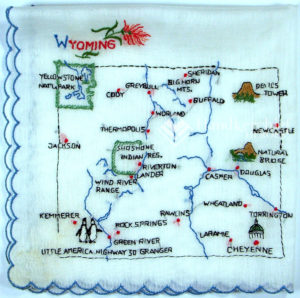
Little America
What are penguins doing in Wyoming? Little America was a hotel chain, originating in Wyoming and included Cheyenne, Salt Lake City, UT and Flagstaff, AZ. Founded in 1952 with two fuel pumps, a café, and 12 rooms, the original location now hosts 140 rooms and 55 fuel pumps. Fifty-five? Yikes. The penguin logo is a reference to Admiral Byrd’s remote Little America station established in Antarctica. The penguin was used to remind travelers there was nothing else available for miles in any direction, so they’d better stop here, rest, and fill the tank. Mighty clever. You can see more of Little America in our Road Trip blog.
Here’s another fun Wyoming hankie that covers all the bases. The reference to Frontier Days is more than just a quaint description of the west. It refers to the “World’s Largest Outdoor Rodeo and Western Celebration” affectionately known as “The Daddy of ‘em All” when it comes to rodeos. It’s been going strong since 1897, and if you’re in the area in July, it’s worth a visit.

This trio of Nebraska images typifies the range of what you might find in souvenir state hankies, from a broad overview (left), to major highlights (center) to individual landmarks (right).
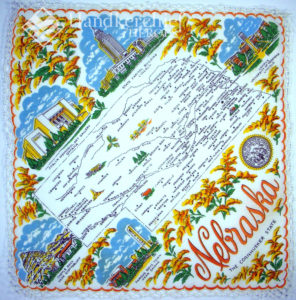 |
 |
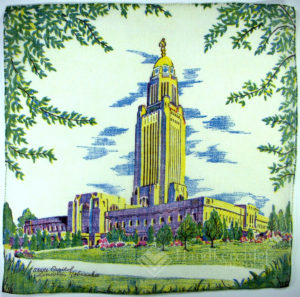 |
We’ll peruse the “highlight hankie” which features a cowboy and an Indian flanking the 100th birthday banner. In addition to universities and coliseums, highlights include Boys Town. Founded in 1917 by Father Edward J. Flanagan, who believed every child could be a productive citizen if given love, a home, an education, and a trade. He accepted boys of every race, color and creed, which was innovative at that time. After WWII President Truman enlisted Flanagan to travel to Asia and Europe to offer advice on how to help children displaced by the war. Many first learned of the orphanage from the 1938 movie Boys Town starring Spencer Tracy and Mickey Rooney.
The Singing Tower refers to a 200 ft. tall neo-Gothic tower that houses a 60 bell carillon alongside the First Plymouth Congregational Church. The bells range in weight from 16 lbs. to 12 tons! Carillon bells are tuned so they can play in any key. The bells themselves do not move, just the clappers which are operated by a keyboard.
Mount Vernon Gardens is a half-scale replica of George Washington’s gardens at Mt. Vernon. Instead of overlooking the Potomac, they overlook the Missouri River, and provide a beautiful venue for weddings and other celebrations.

Some handkerchiefs combine one or more states
 |
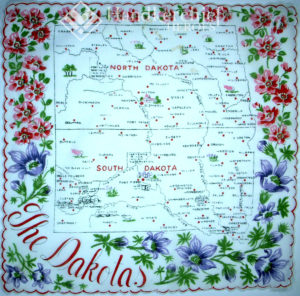 |
While others feature individual states and their landmarks
 |
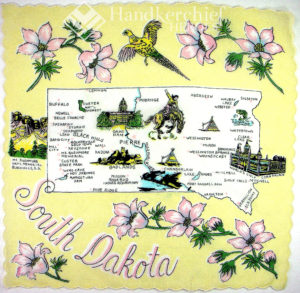 |
A Corn Palace – Who knew?
| In the 19th century, several cities on the great plains constructed “grain palaces” to tout their rich soil and attract visitors to settle in the area. The palace murals were made of corn and other grains, and replaced w/new designs annually. The South Dakota palace shown here hosts a Stampede Rodeo a Polka Festival and is home to Dakota Wesleyan U Tigers and the Mitchell High School Kernels (no kidding) basketball team. What you can learn from a hankie…. | 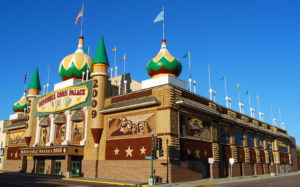 |
Mt. Rushmore
The most recognizable South Dakota landmark is Mt. Rushmore, depicting 60ft. high granite facades of Presidents George Washington, Thomas Jefferson, Theodore Roosevelt, and Abraham Lincoln. Historian Doane Robinson originally conceived of the sculpture as a way to draw tourists to South Dakota, and wanted to feature American West heroes like Lewis and Clark, Chief Red Cloud, and Buffalo Bill Cody, but sculptor Gutzon Borglum thought it would have broader appeal if it featured well known presidents. Visitors to the monument number 2,000,000+ annually.
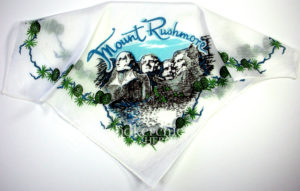
Director Alfred Hitchcock utilized images of Mt. Rushmore to stunning effect in the 1959 movie thriller North by Northwest starring Cary Grant, Eva Marie Saint and James Mason. In 1995 the Library of Congress included the movie in the National Film Registry, citing it as being culturally, historically or aesthetically significant.
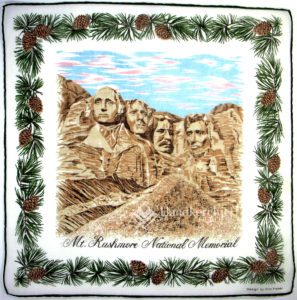
As a final salute to ingenuity and survival of the fittest, we’ll end with an anecdote we first introduced in our cowboy annals.
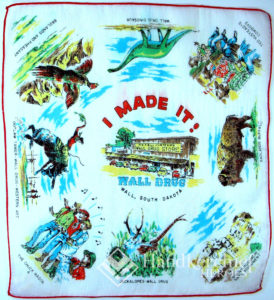
Every hankie tells a story and this one is no exception. In 1931, Ted and Dorothy Hustead were looking for a place to put down roots in a town with a church they could attend daily. Their search led them to the tiny prairie town of Wall, South Dakota, pop. 326, where they purchased the drugstore, and stretched a blanket across the back section to create a “home.” It was the height of the depression, and they gave themselves five years to make a go of it, but by 1936, with a nine year old and a newborn to feed, business hadn’t improved. One hot summer day, with traffic rumbling on Route 16A so fiercely it shook the house, Dorothy had a brainstorm. They staggered signs along the highway (in Burma Shave fashion) offering Free Ice Water. They were instantly mobbed, and by the following year, had to hire eight girls to serve the customers. Today Wall Drug serves up to twenty thousand people on a summer day. (You read that correctly.) So much for little ol’ prairie ingenuity.
Just for Fun
Stanley Marcus
There is neither time nor space in this blog to capture the brilliance that was Stanley Marcus, but I assure you his books are worth reading for the insight and creativity of this arbiter of style. You’ll devour them as the history, stories and anecdotes are fascinating. They include: Minding the Store, Quest for the Best, His & Hers: The Fantasy World of the Neiman Marcus Catalog, Viewpoints of Stanley Marcus, and Stanley Marcus from A to Z. A good biography is Stanley Marcus, The Relentless Reign of a Merchant Prince. We’ll share a quick anecdote here. During WWII, Marcus joined the War Production Board and encouraged clothing designs that would not only save elastic (rubber was rationed) but initiated fashion trends that would save 100,000,000 yards of fabric that could then be devoted to the war effort. During this time he also initiated a Hosiery of the Month Club which sent two pairs of stockings to every female charge card customer. Membership grew by 100,000 nationwide. (He understood both how to conserve, and how to market!)
Brooke Cadwallader
Cadwallader’s life was as colorful as his scarves. When Brooke and Mary moved to the states, they lived in a French Normandy house of their own design nestled in fifty wooded acres in Stamford, Connecticut, and commuted to their baroque salon on 5th Avenue. Their friends ran the gamut from costume designer Adrian (his most famous costumes were for MGM’s The Wizard of Oz) to conductor Arturo Toscanini, from actress Janet Gaynor to Medal of Honor recipient Donald Cook. You can read more about Cadwallder in articles from Colliers 1944, and the New York Post 1947.
Q. What western town was the first city in the U.S. to be totally governed by women?
A. Jackson, WY, which elected a woman mayor and women to all four city council seats in 1920. And there’s your trivia tweet for the day.
Boys Town Movie Trailer
httpv://www.youtube.com/watch?v=1Am2XJ-DUt4





Ann, I marvel at your creativeness in composing this blog! It is so easy to share with my friends.
Thank you so much.
Ann,
This is wonderful. You could be a guest speaker for a TX history class here with all the knowledge just from these hankies! Makes me nostalgic for many things! Loved the bit on Neiman’s since I am from Dallas. Have also been to the Corn Palace and we drive by Boys Ranch each year on the way to Colorado. You could take a tour following these hankies 🙂
You’re exactly right. When people toss hankies they’re throwing away little snippets of history. These sweet accessories prompted me to re-watch the movie Boys Town, which I hadn’t seen since I was a child, as well as read two Stanley Marcus books – one by him and one about him. Great fun. Could I learn all this on line? I suppose so, but where’s the fun in that? Also, you just taught me something new. I was aware of Boys Town, but not Boy’s Ranch, which was also featured in a movie in 1946. Since you’re from TX, I’m curious to know – which is your favorite Texas hankie?
I love reading your blog along with looking at the colorful and beautiful hankies. You’re very clever!!
Thank you for your kind words. Much appreciated. 🙂
the wall drug!
It’s a winner for sure. so much history behind it. did you catch the Wall dinosaur?
Dearest Ann
I enjoyed this blog so much. You are so gifted and a great story teller and weaver
What a rare compilation of historical vignettes!!
Pure genius!!
Thank you for expressing yourself this way
Kristi
Merci beaucoup!